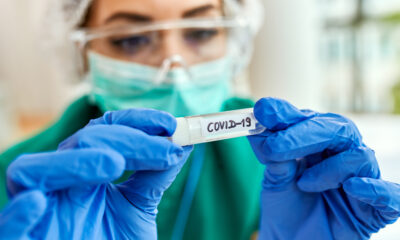
Question and Answer

Clearing the confusion around Omicron
Less than a month ago, the word “omicron” was meaningful only to the Greek community. It’s the 15th letter of the Greek alphabet, leaving only nine letters for future variants. Since Omicron made its debut in mid-November, there has been a deluge of media reporting, more dinner table conversation, and possibly even more social-media communication. One could say that on occasion, information about Omicron may be a tad fanciful or perhaps confusing, if not, maybe, even a trifle contradictory.
To some it will lead to alarm, to others complacency, and to others, perplexity.
So, what have we learnt so far, and what are we in the process of learning? It basically comes down to the uniqueness of this new kid on the block which has caused scientists and authorities to be very guarded in their communication and certainly in their predictions.
What’s so different about the Omicron virus?
- It’s a completely new variant coming off its own independent evolutionary tree, and therefore unrelated to any other previous variant;
- It possess far more mutations than any previous variant, more than 30 in the spike protein alone, and more than double that of Delta, previously the infectivity superman of variants;
- Many of these mutations have never before been seen and, of course, it’s not known how they will affect the personality of the virus; and
- The constellation of these numerous mutations is also unique.
Clearly, much remains to be unravelled about this mysterious new variant and how these mutations, or combinations of them, could translate into its behaviour.
We are now well into the fourth wave, and it’s clearly being driven by Omicron, so, where we are up to with this newest challenge?
- How dangerous is Omicron? Is it causing more or less severe disease?
Many of the clinically ill patients infected with Omicron have been mild to moderate. Certainly, the great majority of those infected after vaccination have been mild. Nevertheless, there has been a significant increase in the incidence of hospital admissions in Gauteng and, to some extent, in KwaZulu-Natal, which reflects the more serious cases. This early pattern was also seen in the early phases of previous COVID-19 waves. The majority of these adult hospital admissions have been in unvaccinated individuals.
What has been striking in this early phase of the fourth wave in Gauteng is the steep rise in the number of hospitalised adolescents and children – steeper than anything seen before. It has been especially notable in the Tshwane metro, where it was reported that the incidence of infection, even in under five-year-old children in public hospitals is second only to that of the over 60-year-old age group. This may well be due to gross under-vaccination of the 12 to 17-year-old age group and absence of vaccination in under 12-year-old children. In addition, apparently very few of the adult carers of these children were vaccinated.
- How effective is the current vaccine in protecting against Omicron?
An increasing number of breakthrough infections, in other words infections occurring in spite of vaccination, are now being seen with Omicron. Fortunately, in the great majority of these cases, the resulting illness has been mild and, in many cases, the COVID-19 infection was picked up only incidentally. Importantly, we can be reasonably confident that COVID-19 vaccines will be very effective – well over 90% – to protect against severe illness due to Omicron. The level of protection against mild illness or protection from just simply being infected, would, however, be somewhat less than that – perhaps more like 50% to 60%.
- How transmissible is Omicron?
One of the very prominent early features of Omicron has been its high transmissibility. The numbers of daily cases nationally have risen dramatically from 169 on 3 November to 273 on 17 November, 4 373 on 1 December, 16 366 on 5 December, and probably much more by the time you read this. The reproductive number – the measure of transmissibility which is determined by the number of susceptible individuals who could be infected by an infectious person – is presently 2.33, the highest it has ever been since the start of the pandemic.
- Will the Omicron variant replace the Delta variant?
The ability of a virus to multiply in a given environment is referred to as its fitness. This is determined by two properties – transmissibility (i.e. contagiousness) as well as its ability to escape from immunity, both natural immunity which follows infection and also artificial immunity following vaccination. On both transmissibility and immune escape, Omicron betters all its competitors. It’s probably about 50% more contagious even than Delta, the erstwhile champion of variants. It’s probable that Omicron will now outcompete Delta to become the dominant variant in South Africa and likely also globally.
- How long will this fourth wave last?
Of course, this is something one cannot predict now in this early stage of the fourth wave. Past waves have lasted between 75 to 100 days. There’s good evidence that the fourth wave may not be as severe as the previous three waves because of high levels of vaccine-induced immunity and high levels of post-infection natural immunity. But that may still depend on levels of vaccine coverage as well as attention to the infection-prevention protocols we all know so well.
- Can we go on holiday, can we have an engagement party, can we go to shul?
The answer is a qualified “yes”. The qualification is provided all attendees are vaccinated, and all of the well-known infection-prevention protocols are diligently carried out. Participating numbers must be limited, functions should be outdoors or, at least, in very well-ventilated indoor venues, proper mask wearing must be enforced, and adequate spacing provided for eating. The elderly and the vulnerable may need to be excluded.
Unfortunately, this year, while it’s a yes for holidays and functions, it shouldn’t be holidays and functions as per usual. Allowances must be made for the poor timing of this fourth wave and this challenging variant.
- Barry Schoub is professor emeritus of virology at the University of the Witwatersrand, and was the founding director of the National Institute for Communicable Diseases. He chairs the Ministerial Advisory Committee on Covid Vaccines. This article is written in his private capacity. He reports no conflicts of interest.











I M Beadle
January 4, 2022 at 10:16 am
THIS SENTENCE “What has been striking in this early phase of the fourth wave in Gauteng is the steep rise in the number of hospitalised adolescents and children” is worrying- why are they even in hospital?
My twice vacced husband had a breakthrough infection, which was like a summer flu, and if we had not both been curious to find out if it was really Covid, we would not even had a test. All symptoms are such, that they can be treated with conventional remedies if you have a decent GP- why the rush to a hospital??
There they will probably treat you with stuff that is killing you (at least that is what they do in the US with remdesivir) – there is NO need to get hospitalised with Omicron. And to say the vaccination is ‘probably’ 90 % effective- is like saying if you dont eat you will probably be hungry ??
and what a statement- its proven and was told us all far too late- that the so-called vaccine is NOT helping-but destroying natural immunity – for giving you around 35-70% cover, and that is waning.
I am sorry that Dr. Schoub is spouting the mainstream media nonsense- instead of allowing people to take care of themselves with a good doc. as they have done for centuries.
I am sorry Dr. Sh